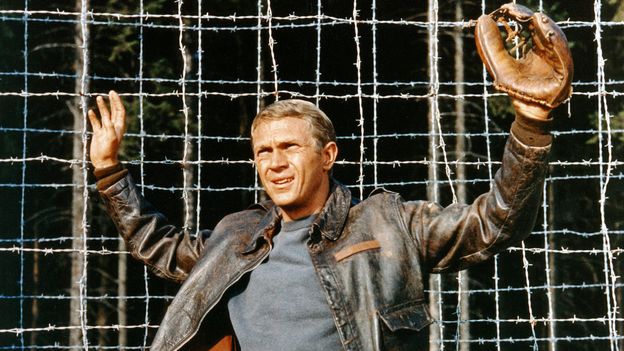The true story of The Great Escape

Other ex-prisoners had a different view of the film. Charles Clarke, who was in the camp at the time, and had aided the plot as a look-out, told the BBC in a 2019 radio interview: “Even after all these years, I’ve always thought what a remarkable film it was.”
One major change that the film made was to the personnel involved. While the events of The Great Escape are mostly rooted in fact, names were changed, and various people were combined into composite characters. At the time of the escape, no Americans remained in the compound, and the man who was said to be the model for McQueen’s Virgil Hilts, William Ash, did not take part. The plan was spearheaded by Squadron Leader Roger Bushell – who in the film was renamed Bartlett, and played by Attenborough. First captured in 1940 after being shot down, Bushell had an impressive record of escape attempts, once getting within 100 yards of neutral Switzerland.
Stalag Luft III was the Germans’ attempt at an escape-proof camp, specifically for air force officers from the UK, Canada, Australia, Poland and other allied countries. It was built and run by the Luftwaffe as a secure place to hold people they believed were escape risks. What they had not done, however, was consider the ramifications of trapping so many escape experts in one place.
Months of preparation
The camp was built over sandy soil that was difficult to tunnel through. This subsoil was also lighter and more yellow than the dark topsoil, making it obvious if any appeared on the ground of the camp. Huts were perched on brick legs to make tunnels down from them obvious. Brickhill describes in his book a “double barbed wire fence nine-feet (2.75m) high”, just outside of which were 15-ft (4.5m) high “goon-boxes” every 100 yards or so, manned by sentries with searchlights and machine-guns. Additionally, microphones were buried in the ground around the wire so that they could pick up the sounds of any tunnelling.
As you might expect from a plan hatched by soldiers, the tunnel-digging enterprise was run with military efficiency. Bushell – also known as “Big X” – was in charge, and delegated certain parts of the organisation to other men. The planning began even before Stalag Luft III was built: Bushell and others knew it was coming, and volunteered to help build it. As a result, they were able to map it out and pick the best spots for a tunnel. Bushell had the idea that they would dig not one tunnel but three simultaneously. The logic was that if the Germans found one of them, they would never suspect that there were two others. They were to be referred to only by their codenames of Tom, Dick and Harry. Bushell threatened to court-martial anyone who even uttered the word “tunnel”.
Source link



